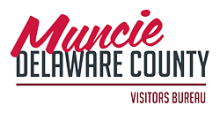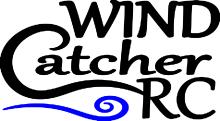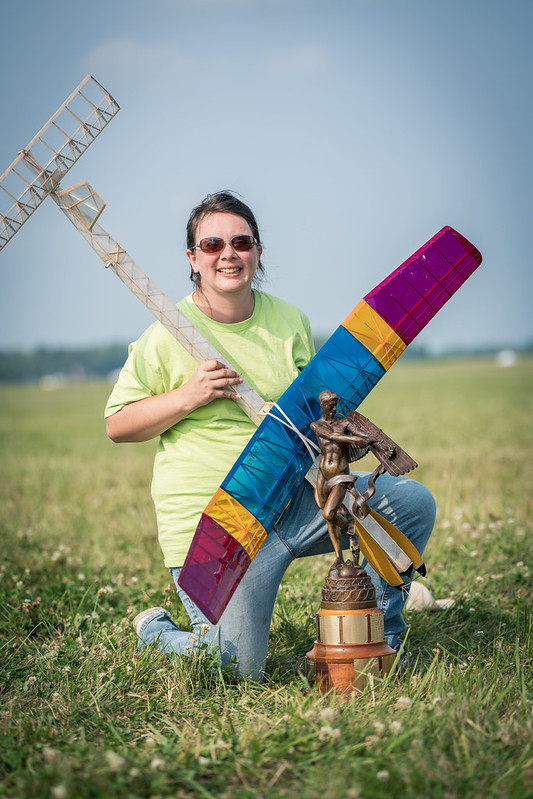- By AMA Communications Director Rob Kurek
- Photos by: Matt Ruddick
One hundred years ago, a handful of model aviation enthusiasts gathered for an event in St. Louis, Missouri, in what would become known as the National Aeromodeling Championships, commonly referred to as the Nats.
That one- day event has grown into three disciplines (Free Flight [FF], Control Line [CL], and Radio Control [RC]), and 14 event categories, often with multiple model competition classes included, spread over four weeks.
This year, the Academy of Model Aeronautics (AMA) celebrated the 100th anniversary of the first Nats, beginning, perhaps appropriately enough, with rubber-powered FF aircraft flown indoors in Moscow, Idaho. It ended weeks later with RC Helicopter at the AMA International Aeromodeling Center (IAC) in Muncie, Indiana.
The Nats were presented by Du-Bro, a legacy US manufacturing company that has been supporting model aviation enthusiasts for decades.
The day-to-day action can be found in NatsNews, an on-line newsletter written by, and for, those who competed or supported the events.
But how does one capture the story of today’s month-long outdoor event? After a month of talking to contestants, it’s clearly about much more than the competition. Model aviation enthusiasts like telling their stories, as evidenced by those who came up to this author frequently, often wanting to talk about others as much, if not more, than themselves.
The word “quintessence” is defined by Webster’s Dictionary as “the essence of a thing in its purest and most concentrated form.” It would seem that word may fit the Nats.
Perhaps it can be measured in the distance some contestants were willing to drive, like Orin Humphries who “drove solo 2,440 miles over six days” to make it to the Nats. Like so many before him, the “road to the Nats” is just part of the story. Just look at the parking lots and note the license plates – home may be Indiana, Illinois, Ohio, Michigan, or much further away.
Perhaps it can be measured in the number of new friends made, or the number of multi-generational families represented, or the times a competitor reached out to help a fellow contestant who is flying in the same event.
“Whether you walk away with a trophy or not, I’m confident you’ll learn something new, meet some new friends, and have a great time,” noted AMA President Rich Hanson in the welcome letter from the Nats Program.
Sure enough, after the first week, themes began to emerge at this year’s Nats. Friendship, camaraderie, family, recognition, learning, helping others, having fun – those precise words were used repeatedly by the competitors themselves.
And being the 100th anniversary of the first Nats made it something special as well.
There was a buzz in the air regarding the 100th-year celebration… and people have taken the time to make the annual trek to Muncie, Indiana,
noted Dan Kane in NatsNews
Make no mistake, the competitiveness of the Nats was no different than in the past – many events featured FAI categories with teams being selected for next year’s world championships (Many are catching up from the COVID pandemic in which events were cancelled or postponed).
This year’s Nats stood out for another reason – the weather. Unlike past events that often experienced near wash-out conditions from storms, this year’s competition featured only two weather-related events that had an impact on Nats events over the course of a month. Perhaps that is a record! Warm weather and hazy conditions from the Canadian wildfires did not seem to interfere with activities or damper the enthusiasm of the contestants.
Hosting the Nats is no small feat for the volunteers and staff at the 1000-acre IAC. Keeping all the flying sites (seven altogether) in top condition requires tremendous effort and dedication, with mowing often going past sundown. For the most part, participants appeared pleased with the sites and the overall hosting of the event.
“The cooperativeness [of the staff and volunteers] and the condition of the field” deserve special mention, said National Society of Radio-Controlled Aerobatics (NSRCA) president Monroe Michaelis. “Those guys [maintenance] have been tremendous to work with.”
Being in the right place at the right time brought it home to this author during week one.
For one bright shining moment, it seemed Site 1 (location of the first flying site at the IAC) was the center of the model aviation world.
If one listened closely enough, you could hear five to six distinct forms of model flying, and you could witness some of the contestants in the air all at the same time. It was a true “flying circus.”
One might have had the opportunity to hear the celebrated take-off of the CL pulse jet engine. Outside of a turbine-powered model aircraft, there is no other model aviation sound quite like it.
While AMA celebrated the 100th anniversary of the first Nats, three Special Interest Groups (SIGS) were commemorating milestones of their own. The National Society of Radio-Controlled Aerobatics (NSRCA), Precision Model Pilots Association (PAMPA), and the Miniature Aircraft Combat Association (MACA) were all celebrating their 50th year at award banquets following the end of their respective contests. SIGs are responsible for running the Nats, a move made by AMA in the mid-1990s.
For the 2023 Nats event, as has probably been the case for decades, the event seemed to capture the essence of a simple theme: fun, friends, and fellowship.
Perhaps these are the elements that separate the Nats from so many other sporting activities. The competitive element is there, to be sure, as noted by AMA District III Vice President Mark Radcliff, who entered his first Nats, one of the celebrated “Navy Nats,” in 1971.

Like so many, he took a break from the event for a few years, in his case, 1980 to 2011. This was his second time competing in RC Scale. Why do it?“For the love of flying,” Mark quickly answered. “It’s the competitive factor, it’s just inbred in me – how good am I?” “You should be happy you beat me,” noted RC Aerobatic pilot Robert Green.
Why come to a Nats? “Coming to where it’s the home of the AMA, it feels good,” Green said. “If you are a modeler you have to experience the AMA first hand. There’s nothing quite like it.”

It’s not just from the US that draws contestants to the Nats. 100 years later, the event draws individuals from all over the world. This year was no exception. To name just a few, there was Andrew Shkolik, currently living in Texas but originally from Belarus, flying RC Combat. There was Maaz Ansari, 13, of India, competing in Sporstman Aerobatics.

Danny Wang attended as well, flying helicopters and participating as part of Team China for the Helicopter World Championships being held at the IAC immediately following the Nats. For him, it was going to be a “trifecta,” as he planned to attend the International Radio Control Helicopter Association (IRCHA) Jamboree held at the IAC at the conclusion of the world championships. Clearly the prestige of the Nats far exceeds the boundaries of the US.
A sense of family binds many to the Nats experience, as is the case for Bob Stalick, former president of the NFFS, who has participated in 22 Nats.
“This is third generation stuff for us,” he said. “It’s about the people as much as the flying. I see these (other) people once a year and some of them truly are like family.”
Bob Stalick
Reminded that this was the 100th Centennial of the first Nats, Stalick noted, “That’s a hallmark. What’s this going to look like 100 years from now?”
“People are very friendly, not super intense about it (the event),” his son Tom added. “If there is a new flyer at the field, there are always people around willing to help.”
But the sense of friendliness and camaraderie seems to extend to all the events in all three disciplines. Perhaps nothing exemplifies this when one hears a competitor ask another, “How did you do that” or, “can I borrow a tool or part.” Imagine pit crews at the Indianapolis 500 or some other sporting event doing the same thing. Not likely!
It was not hard finding first-time Nats contestants, although they were in the minority compared to the “veterans.” Take Milton Renno flying Sportsman Pattern, for example. “This has been wonderful… I want to learn,” he said. “My goal was to come to the Nats and fly as good as I could… I have a lot to learn but this really is the best place for that… the atmosphere – everyone is trying to help one another. It’s not “cutthroat, everyone is mentoring. I walk around, see airplanes, and ask a lot of questions.”
Lee Ray and his son, Austin, participated in their first Nats. Lee is AMA’s Social Media Manager, and brought along his father’s soaring model. The Rays represented one of several third-generation model aviation families that attended the Nats.
“If you’ve never attended a Nats do so… pick an event that means something to you,” Lee said. “If your passion is this hobby, put Nats on your schedule to attend.
“It’s definitely looks competitive, but I just want to have fun and we want our planes to come back in one piece,” joked Austin.
Hope Finn Wins Adult Mulvihill Event
The morning of the Mulvihill event, July 18, found the sun cutting through some haze from the Canadian wildfires, with a light breeze and about 65 degrees… not bad for an Indiana mid-summer day. At precisely 8 a.m., a horn blew, and National Free Flight Society (NFFS) president David Lindley announced, “Round one is open.”
Other events were flown that day, but it seemed there was an air of anticipation around Mulvihill. History, after all, had come to call on a field in Muncie, Indiana, roughly a seven-hour drive from the first event 100 years ago.
There was a quiet calmness at the flying site for the FF community. Most Free Flighters arranged their tents and equipment facing east, based on wind conditions. Walking among the participants, one could hear discussions of where and when to launch, wind conditions, talking strategy for the morning. In the distance, soaring aircraft were already in the air at another site.
To those unfamiliar with Outdoor FF, it may have been a strange sight to see a few bubble machines spread throughout the field. The kids surely took delight, but they were there for a reason, helping determine wind direction and conditions.
“Bubbles lie,” one competitor wryly noted.
“I don’t like this wind direction,” one contestant said.
Perhaps one participant’s T-shirt summed it all up – “Altitude is Everything.”
Like most Nats events, it was a family affair. There were the Finns – Joshua, Caleb, Paul Richard, and Hope.

The Reuters were well represented with William E., Becham W., and Wes, all flying Junior and Senior FF Events. And Dom DeLouch managed to bring his daughter, Skilly, one more time.
The first launch of the day was Gerald S. Brown, launching his aircraft into the wind at 8:10 a.m.
“It’s all aerodynamics,’ said Rick Pangell. “It’s actually pretty technical but it’s not out of the reach of the average flyer. [FF] is the first, the oldest form of aeromodeling. It’s where it all started.”
Dom DeLoach, NatsNews reporter for indoor and outdoor FF, noted the following about the Mulvihill event in his July 18 event filing:
“The Bernard H. Mulvihill trophy is the oldest continuously awarded Nats trophy in existence. 2023 marks the 100th anniversary of the first Mulvihill contest, a monumental milestone. Back then, models were made of dense bamboo and hardwood and were lucky to fly more than a minute or two. Models have improved a lot since then.
Today’s seasoned Free Flighters sometimes try almost every year and only win the Mulvihill once, twice … or never! It has always been awarded to the highest score, regardless of age, in the AMA Mulvihill event, a rubber event with no restrictions other than wing area being under 300 sq. in.
This year, twenty fliers entered the fray in Mulvihill. Skilly DeLoach took home top honors in Junior with a total of 540, and Henry Forster won Senior with 429. The Adult winner was a relative youngster and newcomer to the event, Hope Finn. Hope scored seven progressive maxes for a total of 1620 seconds … so far, the high time of the Nats. Winning the Mulvihill is undoubtedly a day she’ll never forget.”
Paul Finn described the Mulvihill contest in a larger context, one representative of how model airplanes still play a role in our society.
“There’s something about the connection flying this (event) to the greatest aeronautical engineers that ever lived,” he said. “We’re flying that same legacy.”
In fact, many competitors linked building and flying model airplanes to STEM education and as a pathway to related careers. This author heard the word “engineering” at least a dozen times during several dozen interviews.
Lindley added, “this continues to be one of the most prestigious awards across all disciplines – we have people who have worked their whole lives to win this trophy, and it’s important to the country and the world.”
“It’s very important for us to get the next generation involved in this (model aviation),” Hope noted.

Chris Wolfe, a well-known RC media influencer known as the “RC Geek,” also was attending his first Nats.
“If you are looking to become a better pilot, this is the place to come,” Wolfe said. “I learn something after every competition.
Chris Wolfe
“I’m always happy to help others and that is in the spirit of competition. You want to help people be at their best. It’s a very welcoming atmosphere – it’s a challenge but it’s fun. You do have to come in with realistic expectations. You can leave knowing what it takes to succeed in the years to come.”

Wolfe produced an 18-minute video commemorating the event that can be found on his YouTube channel:
Inspiring others to attend a Nats was a story repeated often.
“My dad flies pattern. He has inspired me and helped me – I’ve loved model airplanes since I was a kid,” said Tom Dose, 18, flying his second Nats.
“That’s the beauty of the AMA Nats versus a Scalemasters or Top Gun event, you don’t have to qualify to fly. Bringing a friend and convincing them to come is actually pretty easy,” noted Jim Reddiske.
This is almost like a Sunday fun fly with a little angst thrown in for good measure! You leave with lifelong friendships.
Jim Reddiske
Over the course of 29 days, it became abundantly clear this was a model aviation event unlike any other. AMA’s marketing slogan for many years was “bringing modelers together.” That certainly appeared to describe the Nats culture this year and probably for many years past.
A few more observations from this year’s Nats: Longtime Model Aviation FF columnist Louis Joyner reliving some model retrieval episodes that elicited a laugh and an appreciation for the discipline of the sport unlike any other. Yes, modelers are storytellers!
This author noticed how some flyers, in this case IMAC participants, use a brand name “natural artisan water” plastic bottle to carry fuel inside the fuselage. One learns something new every day.
There are unique names given to models, like “Loose Change” and “Chase the Dream Not the Competition.” In addition, trailers used to haul models proudly displaying a club’s name, such as the Mohawk Valley Radio Control Modelers.
Speaking of trailers, along with the trucks, vans and other vehicles on site, there is value in seeing up close model packing techniques. These folks know how to transport their gear! This author got a few “pro tips” from Soaring competitor Amy Poole.

Here are some insights from the competitors in their own words:
It’s not the competition now that is the most important. It’s mainly the camaraderie… it’s like going to several family reunions. But when I go out on the (flight) line, I try to do the best I can.
Al Kretz, 20th Nats
There’s a lot of people I’ve known for years that I don’t see except for this week. It’s a lot of fun and I’ve been flying since I was 11.
Michael Urban
It’s (model aviation) a healthy life as it utilizes everything you have. The best part is the people you meet and share it with, like here at the Nats.
Orin Humphries
The airplane part is a lot of fun, but it’s more fun with the people. This is a great community of people who help each other. A competitor will give you anything he has in his toolbox… even if he thinks you are going to beat him. It doesn’t matter – this is family. This experience of being here with people of a similar interest does not compare with anything else I’ve done in my lifetime.
Bob Hunt, former Model Aviation editor and winner, Nats and World Championships

The first two times I just came and watched. I just like it more now.
Sarah Delecki, FF competitor
She had no choice, she’s been dragged to this event for ten years… it’s just a great time, it’s very open and friendly, more like a family event. It is hard, it’s 12 hours in the sun. After all this is a competition.
George Delecki (dad)
If you like competition and you like racing, it’s (the Nats) the only way to do it in model aviation.
Mike Hesel, RC Pylon flyer
I’ve been doing Nats for about 60 years. “What brings me back are all the friends I’ve had over 50 years. (To Nats newcomers) Come and see the Nats to start with, to see what the beginners do.
John Ballard, former Model Aviation CL columnist
I keep trying to finish building my model, that’s my inspiration to come back to the Nats.
Richard Reynolds
What brings you back… I come for the camaraderie, the friendships. Modelers are just really nice people. I still like the competition because it makes you a better flyer. I primarily come because I want to hang out with my friends.
Dale Arvin
The friendships and the competition (brings me back). I just really enjoy the aviation aspect of it… it drove my career (as an engineer) so it’s just something I have a real passion for.
Gary Freeman, attending Pylon with son Brody
You get to see a lot of people don’t see very often. Seeing these people face to face is just a lot of fun. It’s a very friendly competition. If someone has a problem, people are here to help.
Peter Bauer

It’s just a gathering of friends, with a competition thrown in. It’s not ‘dog eat dog.’ We really help each other. Control Line guys are like that.
Mark Hughes
I’m just here because I like to fly model airplanes.
Dave Pierce
We want him (Maaz Ansari) to have that exposure, or contact, with other pilots. Where else but the Nats? How experienced these pilots are… why not learn from the best?
Wasiriyaz Ansari
The AMA would like to thank the following additional sponsors of the Nats:
Diamond

Platinum


Gold



Silver



AMA Friend



Are NATS competitors still required to sign a “builder of the model” statement?
No, you do not have to declare the “builder of model” (BoM) on the AMA website when you sign up for individual events, BUT there are several AMA NATS events that require you to be the BoM and would ask at the event for you to declare this. For example, several control line precision aerobatic events, RC/CL/FF scale events would require this. Familiarize yourself with the rules in your individual category by going to: https://www.modelaircraft.org/events/competition-resources/competition-regulations